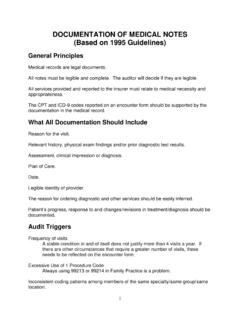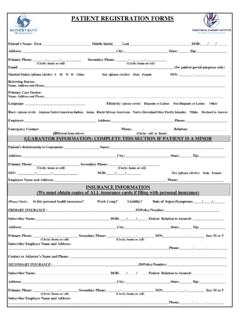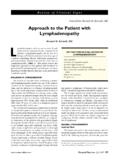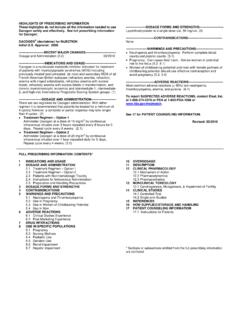Transcription of [Product Monograph Template - Standard] - …
1 Pheburane product Monograph Page 1 of 24 product Monograph PrPheburane Sodium phenylbutyrate granules 483 mg per gram of granules ATC Code: A16AX03 Alimentary tract and metabolism product M dunik Canada 950, boul. Mich le-Bohec Blainville, Qu bec Canada, J7C 5E2 Date of Preparation: June 13, 2014 Date of Revision : December 6, 2017 Submission Control No: 209765 Pheburane product Monograph Page 2 of 24 Table of Contents PART I: HEALTH PROFESSIONAL INFORMATION ..3 SUMMARY product INFORMATION ..3 INDICATIONS AND CLINICAL USE ..3 CONTRAINDICATIONS ..3 WARNINGS AND PRECAUTIONS ..4 ADVERSE REACTIONS.
2 5 DRUG INTERACTIONS ..7 DOSAGE AND ADMINISTRATION ..8 OVERDOSAGE ..12 ACTION AND CLINICAL PHARMACOLOGY ..12 STORAGE AND STABILITY ..15 SPECIAL HANDLING INSTRUCTIONS ..15 DOSAGE FORMS, COMPOSITION AND PACKAGING ..15 PART II: SCIENTIFIC INFORMATION ..16 PHARMACEUTICAL INFORMATION ..16 CLINICAL TRIALS ..16 DETAILED PHARMACOLOGY ..17 TOXICOLOGY ..18 REFERENCES ..20 PART III: CONSUMER Pheburane product Monograph Page 3 of 24 PrPHEBURANE (sodium phenylbutyrate) PART I: HEALTH PROFESSIONAL INFORMATION SUMMARY product INFORMATION Route of Administration Dosage Form / Strength Clinically Relevant Nonmedicinal Ingredients Oral Coated granules / 483 mg sodium phenylbutyrate /g Sucrose For a complete listing see DOSAGE FORMS, COMPOSITION AND PACKAGING.
3 INDICATIONS AND CLINICAL USE Pheburane (sodium phenylbutyrate) is indicated as adjunctive therapy in the chronic management of urea cycle disorders, involving deficiencies of carbamylphosphate synthetase, ornithine transcarbamylase or argininosuccinate synthetase. Pheburane should be used with dietary protein restriction and, in some cases, dietary supplements ( , essential amino acids, arginine, citrulline, and protein-free calorie supplements). Pheburane is indicated in patients with neonatal-onset presentation (complete enzyme deficiencies, presenting within the first 28 days of life). It is also indicated in patients with late-onset disease (partial enzyme deficiencies, presenting after the first month of life) who have a history of hyperammonemic encephalopathy.
4 Geriatrics (> 65 years of age) Pheburane has not been studied in the geriatric population. CONTRAINDICATIONS Hypersensitivity to sodium phenylbutyrate or to any ingredient in the formulation (for a complete listing, see the DOSAGE FORMS, COMPOSITION AND PACKAGING section of the product Monograph ); Pregnancy; Breastfeeding. Pheburane product Monograph Page 4 of 24 WARNINGS AND PRECAUTIONS General Episodes of acute hyperammonemic encephalopathy may occur in patients even when they are on Pheburane therapy. Pheburane is not recommended for the management of acute hyperammonemia, which is a life-threatening medical emergency that requires more rapidly acting interventions to reduce plasma ammonia levels.
5 Sodium content Pheburane contains 124 mg ( mmol) of sodium per gram of sodium phenylbutyrate, corresponding to g (108 mmol) of sodium per 20 g of sodium phenylbutyrate ( the maximum daily dose). Pheburane should be used with extreme caution, if at all, in patients with congestive heart failure or severe renal insufficiency, and with care in patients on a controlled sodium diet or in clinical conditions where there is sodium retention with edema. Serum potassium levels Serum potassium should be monitored during therapy since renal excretion of phenylacetylglutamine may induce urinary loss of potassium. Sucrose content Pheburane contains 768 mg of sucrose for each gram of sodium phenylbutyrate, corresponding to g of sucrose in the maximum daily dose of 20 g of sodium phenylbutyrate.
6 This should be considered in patients with diabetes mellitus. Patients with rare hereditary problems of fructose intolerance, glucose-galactose malabsorption or sucrase-isomaltase insufficiency should not take Pheburane. Hepatic Since sodium phenylbutyrate is metabolized in the liver and kidneys, Pheburane should be used with caution in patients with hepatic insufficiency (see WARNINGS AND PRECAUTIONS, Monitoring and Laboratory Tests). Renal Sodium phenylbutyrate is metabolized in the liver and kidneys to phenylacetylglutamine, which is primarily excreted by the kidneys. Pheburane should therefore be used with caution in patients with renal insufficiency ( see WARNINGS AND PRECAUTIONS, Monitoring and Laboratory Tests).
7 Neurologic The major metabolite of sodium phenylbutyrate, phenylacetate, is associated with neurotoxicity. In a study of cancer patients administered phenylacetate intravenously, signs and symptoms of neurotoxicity were seen at plasma concentrations mmol/l, including somnolence, fatigue, light headedness, headache, dysgeusia, hypoacusis, disorientation, impaired memory, and exacerbation of pre-existing neuropathy. The adverse events were reversible upon discontinuation. Pheburane product Monograph Page 5 of 24 If symptoms of vomiting, nausea, headache, somnolence, confusion, or sleepiness are present in the absence of high ammonia levels or other intercurrent illnesses, consider reducing the dose of Pheburane, and assessment of plasma phenylacetate level may be useful ( see WARNINGS AND PRECAUTIONS, Monitoring and Laboratory Tests).
8 Sexual Function/Reproduction The effect of sodium phenylbutyrate on fertility in humans is unknown. Amenorrhea/menstrual dysfunction was common in menstruating women administered sodium phenylbutyrate (see ADVERSE REACTIONS). Special Populations Pregnant Women: The safety of this medicinal product for use in human pregnancy has not been established. Animal studies have shown adverse effects on the fetus ( see TOXICOLOGY, Reproduction). Because the significance of these data in pregnant women is not known, the use of Pheburane is contraindicated during pregnancy (see C ONTRAINDICATIONS). Effective contraceptive measures must be taken by women of child-bearing potential.
9 Nursing Women: It is not known if phenylacetate is secreted in human milk, therefore the use of Pheburane is contraindicated during breastfeeding (see CONTRAINDICATIONS). Geriatrics (> 65 years of age): Pheburane has not been studied in the geriatric population. Monitoring and Laboratory Tests Plasma levels of ammonia, arginine, essential amino acids (especially branched chain amino acids), carnitine and serum proteins should be maintained within normal limits. A fasting plasma ammonia level of less than half the age-adjusted upper limit of normal (ULN) has been used as a therapeutic target, and plasma glutamine should be maintained at levels less than 1,000 mol/L.
10 Urinalysis, blood chemistry profiles, and hematologic tests should be monitored routinely. Serum drug levels of phenylbutyrate and its metabolites, phenylacetate and phenylglutamine, may be monitored periodically. In particular, plasma phenylacetate levels may be useful to guide dosing if symptoms of vomiting, nausea, headache, somnolence, confusion, or sleepiness are present in the absence of high ammonia or intercurrent illness. ADVERSE REACTIONS Adverse Drug Reaction Overview The most common clinical adverse event reported was amenorrhea/menstrual dysfunction (irregular menstrual cycles), which occurred in 23% of menstruating female patients.




